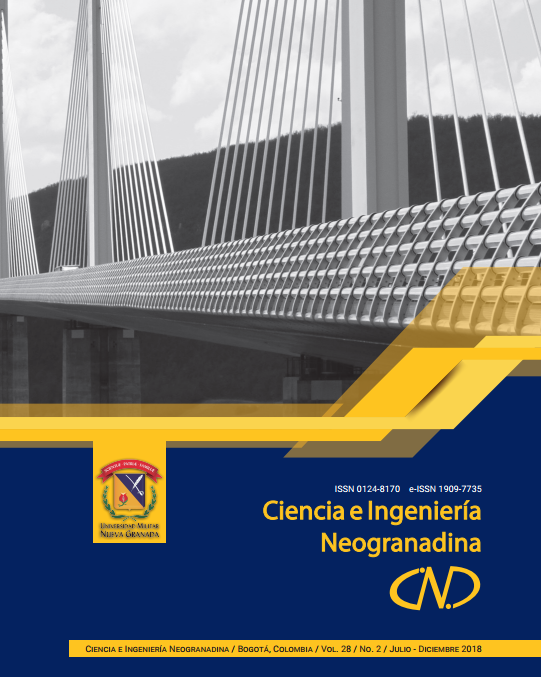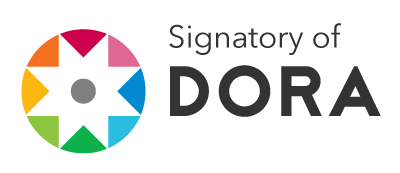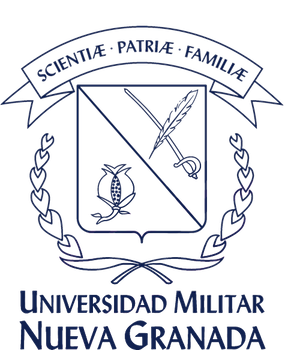Autochthonous microbial consortium for diesel contaminated water treatment from Toas Island harbor (Venezuela)
Abstract
The biological treatment of contaminated water using autochthonous microbial consortia harnesses the metabolic potential of different groups of microorganisms to degrade and/or remove a wide variety of compounds. Additionally, biostimulation and bioaumentation techniques contribute to enhance the capabilities of these biodegradation processes. The objective of this work was to evaluate the use of an autochthonous microbial consortium (Chlorella spp.-bacteria) for the treatment of water from the Toas island harbor (Lake Maracaibo, Venezuela), contaminated with 1% v/v diesel. For this, two treatments (T1: biostimulated and T2: bioaumented) and a control for 70 days were used, at a scale of 20 L and controlled environmental conditions. During the tests, temperature, pH, chemical oxygen demand (COD), nitrite, nitrate, total Kjeldahl nitrogen, total nitrogen (N-total), orthophosphate, total phosphorus (P-total), total petroleum hydrocarbons (TPH), hydrocarbon fractions (SARA), microalgal and bacterial density, and photosynthetic pigments were monitored, according to standardized methods. The mean values for organic matter removal (COD), N-total and P-total, were: 23.3±2.3; 35.2±4.5 and 64.6±4.8%, of 27.6±1.64; 79.8±2.05 and 87.7±1.95%, and of <0.1; 16.1±0.38 and 44.7±1.18%, to the control, T1 and T2, respectively. The final concentrations of HTP were above the permissible limit of Venezuelan regulations for discharge to natural water bodies; however, high rates of removal of saturated and aromatic hydrocarbons (>70%) were obtained, particularly in the bioaumented treatment (T2). The autochthonous microbial consortia have great potential for the bio-recovery of water from the Toas island harbor, contaminated with petroleum hydrocarbons, which is why it is recommended to continue investigating this treatment technology.
Downloads
Languages:
esSupport agencies:
Observatorio Nacional de Ciencia, Tecnología e Innovación (ONCTI), Proyecto PEII Nro. 2011001259, Consejo de Desarrollo Científico y Humanístico (CONDES) de La Universidad del Zulia, Proyecto Nro. CC-0592-14References
Das, N. y Chandran, P. (2011). Microbial degradation of petroleum hydrocarbon contaminants: an overview. En: Biotechnology Research International, Vol. 2011, pp. 1-13. https://doi.org/10.4061/2011/941810
Omojevwe, E.G. y Ezekiel, F.O. (2016). Microalgal-bacterial consortium in polyaromatic hydrocarbon degradation of petroleum - based effluent. En: Journal of Bioremediation & Biodegradation, Vol. 7(4), pp. 1-5. https://doi.org/10.4172/2155-6199.1000359
Sayara, T., Borràs, E., Caminal, G., Sarrà, M. y Sánchez, A. (2011). Bioremediation of PAHs-contaminated soil through composting: Influence of bioaugmentation and biostimulation on contaminant biodegradation. En: International Biodeterioration & Biodegradation, Vol. 65, pp. 859-865. https://doi.org/10.1016/j.ibiod.2011.05.006
Subashchandrabose, S.R., Ramakrishnan, B., Megharaj, M., Venkateswarlu, K. y Naidu, R. (2011). Consortia of cyanobacteria/microalgae and bacteria: biotechnological potential. En: Biotechnology Advances, Vol. 29, pp. 896-907. https://doi.org/10.1016/j.biotechadv.2011.07.009
Alexander, M. (1999). Biodegradation and bioremediation. 2nd edition. San Diego. Academic Press. 325 p.
Seo, J.S., Keum, Y.S. y Li, Q.X. (2009). Bacterial degradation of aromatic compounds. En: Int. J. Environ. Res. Public Health, Vol. 6, pp. 278- 309. https://doi.org/10.3390/ijerph6010278
Abbasian, F., Lockington, R., Mallavarapu, M. y Naidu, R. (2015). A comprehensive review of aliphatic hydrocarbon biodegradation by bacteria. En: Appl. Biochem. Biotechnol., Vol. 176(3), pp. 1-30. https://doi.org/10.1007/s12010-015-1603-5
Varjani, S. (2017). Review: microbial degradation of petroleum hydrocarbons. En: Bioresource Technology, Vol. 223, pp. 277-286. https://doi.org/10.1016/j.biortech.2016.10.037
Braggs, J.R., Prince, R.C., Harrier, E.J. y Atlas, R.M. (1994). Atlas, effectiveness of bioremediation for the Exxon Valdez oil spill. En: Nature, Vol. 368, pp. 413-418. https://doi.org/10.1038/368413a0
El Fatah, R.A., Sorour, N.M. y Yeheia, D.S. (2016). Biodegradation of crude oil by Anabaena oryzae, Chlorella kessleri and its consortium under mixotrophic conditions. En: International Biodeterioration & Biodegradation, Vol. 112, pp. 128-134. https://doi.org/10.1016/j.ibiod.2016.05.001
Manzoor, M., Ma, R., Shakir, H.A. Tabssum, F. y Qazi, J.I. (2016). Microalgal-bacterial consortium: a cost-effective approach of wastewater treatment in Pakistan. En: Punjab Univ. J. Zool., Vol. 31(2), pp. 307-320.
Gonçalves, A.L., Pires, J.C.M. y Simões, M. (2017). A review on the use of microalgal consortia for wastewater treatment. En: Algal Research. En prensa. https://doi.org/10.1016/j.algal.2016.11.008
Barrios, Y. (2011). Biorremediación: una herramienta para el saneamiento de ecosistemas marinos contaminados con petróleo. En: Biotecnología Aplicada, Vol. 28(2), pp. 60-68.
Colin, V.L., Villegas, L.B. y Abate, C.M. (2012). Indigenous microorganisms as potential bioremediators for environments contaminated with heavy metals. En: International Biodeterioration & Biodegradation, Vol. 69, pp. 28-37. https://doi.org/10.1016/j.ibiod.2011.12.001
Xu, N., Bao, M., Sun, P. y Li, Y. (2013). Study on bioadsorption and biodegradation of petroleum hydrocarbons by a microbial consortium. En: Bioresource Technology, Vol. 149, pp. 22-30. https://doi.org/10.1016/j.biortech.2013.09.024
Mrozik, A., Piotrowska-Seget, Z. y Labuzek, S. (2003). Bacterial degradation and bioremediation of polycyclic aromatic hydrocarbons. En: Polish Journal of Environmental Studies, Vol. 12(1), pp. 15-25.
Lei, A.P., Hu, Z.L., Wong, Y.S. y Tam, N.F. (2007). Removal of fluoranthene and pyrene by different microalgal species. En: Bioresour. Technol., Vol. 98(2), pp. 273-280. https://doi.org/10.1016/j.biortech.2006.01.012
Zeng, X., Guo, X., Su, G., Danquah, M.K., Zhang, S., Lu, Y., Sun, Y. y Lin, L. (2015). Bioprocess considerations for microalgal-based wastewater treatment and biomass production. En: Renewable and Sustainable Energy Reviews, Vol. 42, pp.1385-1392. https://doi.org/10.1016/j.rser.2014.11.033
Mujtaba, G., Rizwana, M. y Lee, K. (2017). Removal of nutrients and COD from wastewater using symbiotic co-culture of bacterium Pseudomonas putida and immobilized microalga Chlorella vulgaris. En: Journal of Industrial and Engineering Chemistry. En prensa. https://doi.org/10.1016/j.jiec.2017.01.021
Hamza, H.A., Hamouda, R.A., Husein, M.H. y Abd-Elwahid, S.S. (2013). The characteristics of biomass production and lipid accumulation of Chlorella kessleri growth under mixotrophic and heterotrophic conditions. En: Egypt. J. Exp. Biol. Bot., Vol. 9, pp. 19-26.
Pérez-García, O., De-Bashan, L.E., Hernández, J.P. y Bashan, Y. (2010). Efficiency of growth and nutrient uptake from wastewater by heterotrophic, autotrophic, and mixotrophic cultivation of Chlorella vulgaris immobilized with Azospirillum brasilense. En: J. Phycol., Vol. 46, pp. 800-812. https://doi.org/10.1111/j.1529-8817.2010.00862.x
Andreolli, M., Lampis, S., Brignoli, P. y Vallini, G. (2015). Bioaugmentation and biostimulation as strategies for the bioremediation of a burned woodland soil contaminated by toxic hydrocarbons: a comparative study. En: Journal of Environmental Management, Vol. 153, pp. 121-131. https://doi.org/10.1016/j.jenvman.2015.02.007
Hassanshahian, M., Emtiazi, G., Caruso, G. y Cappello, S. (2014). Bioremediation (bioaugmentation/biostimulation) trials of oil polluted seawater: a mesocosm simulation study. En: Marine Environmental Research, Vol. 95, pp. 28-38. https://doi.org/10.1016/j.marenvres.2013.12.010
Olaniran, A. O., Pillay, D. y Pillay, B. (2006). Biostimulation and bioaugmentation enhances aerobic biodegradation of dichloroethenes. En: Chemosphere, Vol. 63, pp. 600-608. https://doi.org/10.1016/j.chemosphere.2005.08.027
Nikolopoulou, M., Pasadakis, N. y Kalogerakis, N. (2013). Evaluation of autochthonous bioaugmentation and biostimulation during microcosm-simulated oil spills. En: Marine Pollution Bulletin, Vol. 72, pp. 165-173. https://doi.org/10.1016/j.marpolbul.2013.04.007
Herrero, M. y Stuckey, D.C. (2015). Bioaugmentation and its application in wastewater treatment: a review. En: Chemosphere, Vol. 140, pp. 119-128. https://doi.org/10.1016/j.chemosphere.2014.10.033
Shukla, S.K., Mangwani, N., Rao, T.S y Das, S. (2014). Biofilm-mediated bioremediation of polycyclic aromatic hydrocarbons. Chapter 8. Microbial Biodegradation and Bioremediation. Elsevier Inc. pp. 203-232. https://doi.org/10.1016/B978-0-12-800021-2.00008-X
Otero-Paternina, A., Cruz-Casallas, P.E. y Velasco-Santamaría, Y.M. (2013). Evaluación del efecto del hidrocarburo fenantreno sobre el crecimiento de Chlorella vulgaris (Chlorellaceae). En: Acta Biol. Colomb., Vol. 18(1), pp. 87-98.
Alburgue, D., Díaz-Borrego, L., Marín, J. y Morales, E. (2017). Efecto de la bioestimulación y bioaumentación sobre la remoción de contaminantes en agua del puerto de Isla de Toas. En: Revista de la Facultad de Ingeniería U.C.V. En prensa.
APHA, AWWA y WEF. (2005). Standard methods for the examination of water and wastewater. 21th edition. New York. American Public Health Association. 1427 p.
Tortora, G., Funke, C. y Case, L. (2007). Introducción a la microbiología. 9na edición. Buenos Aires. Editorial Médica Panamericana S. A. 959 p.
Jeffery, S. y Humphrey, G. (1975). Nuevos ecuaciones espectrofotométricos para la determinación de clorofilas a, b, c1, y c2 en las plantas superiores, las algas y el fitoplancton natural. En: Biochemistry Physiology Pflanz, Vol. 167, pp. 191-198.
Strickland, J. y Parsons, T. (1972). A manual of sea water analysis. En: Canada Fisheries Research Board Bulletin, Vol. 167, pp. 310-315.
Maier, R.M. (2009). Bacterial Growth. Chapter 3. En: Environmental Microbiology, Part 1, Review of Basic Microbiological Concepts. Academic Press. Inc. pp. 37-54. https://doi.org/10.1016/B978-0-12-370519-8.00003-1
Okpokwasili, G.C. y Nweke, C.O. (2005). Microbial growth and substrate utilization kinetics. En: African Journal of Biotechnology, Vol. 5(4), pp. 305-317.
Hernández, D. Biodegradación de gasoil por bacterias aisladas de agua contaminada con hidrocarburos en Isla de Toas, estado Zulia (Trabajo Especial de Grado). (2014). Facultad Experimental de Ciencias, Universidad del Zulia. Maracaibo. 86 p.
Decreto 883. (1995). Normas para la clasificación y el control de la calidad de los cuerpos de agua y vertidos o efluentes líquidos. Gaceta Oficial de la República Bolivariana de Venezuela Nº 5.021. Caracas.
Esteves, F. (1998). Fundamentos de limnologia. 2a edição. Rio de Janeiro. Intenciência. 226 p.
Adoki, A. (2008). Response of microalgae from mud-flats to petroleum hydrocarbons in the presence of nitrogenous fertilizer effluents. En: African Journal of Biotechnology, Vol. 7(5), pp. 622-630.
Díaz, L. Crecimiento de microalgas y bacterias asociadas provenientes de una fosa petrolera en presencia de queroseno y su efecto en la producción de pigmentos y composición bioquímica microalgal (Trabajo de Ascenso). (2012). Facultad Experimental de Ciencias, Universidad del Zulia. Maracaibo. 96 p.
Madigan, M., Martinko, J. y Parker, J. (2003). Brock: Biología de los microorganismos. 10a edición. Madrid. Pearson Prentice Hall. 1089 p.
Balba, M., Al-Awadhi, N. y Al-Daher, R. (1998). Bioremediation of oil-contaminated soil: microbiological methods for feasibility assessment and field evaluation. En: Journal of Microbiological Methods, Vol. 32, pp. 155-164. https://doi.org/10.1016/S0167-7012(98)00020-7
Riaño, B., Hernández, D. y García-González, M.C. (2012). Microalgal-based systems for wastewater treatment: Effect of applied organic and nutrient loading rate on biomass composition. En: Ecological Engineering, Vol. 49, pp.112-117. https://doi.org/10.1016/j.ecoleng.2012.08.021
Mannina, G., Cosenza, A., Di Trapani, D., Capodici, M. y Viviani, G. (2016). Membrane bioreactors for treatment of saline wastewater contaminated by hydrocarbons (diesel fuel): an experimental pilot plant case study. En: Chemical Engineering Journal, Vol. 291, pp. 269-278. https://doi.org/10.1016/j.cej.2016.01.107
Beylier, M.R., Balaguer, M.D., Colprim, J., Pellicer-Nàcher, C., Ni, J.B., Smets, B.F., Sun, S.P. y Wang, R.C. (2011). Biological nitrogen removal from domestic wastewater. Second Edition. En: Reference Module in Earth Systems and Environmental Sciences, from Comprehensive Biotechnology, Vol. 6, pp. 329-340. https://doi.org/10.1016/B978-0-08-088504-9.00533-X
Schmidt, I., Sliekers, O., Schmid, M., Bock, E., Fuerst, J., Kuenen, J., Jetten, M. y Strous, M. (2003). New concepts of microbial treatment processes for the nitrogen removal in wastewater. En: FEMS Microbiology Reviews, Vol. 27, pp. 481-492. https://doi.org/10.1016/S0168-6445(03)00039-1
Montemezzani, V., Duggan, I.C., Hogg, I.D. Craggs, R.J. (2015). A review of potential methods for zooplankton control in wastewater treatment high rate algal ponds and algal production raceways. En: Algal Research, Vol. 11, pp. 211-226. https://doi.org/10.1016/j.algal.2015.06.024
Si-Zhong, Y., Hui-Jun, J., Zhi, W., Rui-Xia, H., Yan-Jun, J., Xiu-Mei, L. y Shao, Y. (2009). Bioremediation of oil spills in cold environments: a review. En: Pedosphere, Vol. 19(3), pp. 371-381. https://doi.org/10.1016/S1002-0160(09)60128-4
Riquelme, C. y Avendaño, R. (2003). Interacción bacteria-microalga en el ambiente marino y uso potencial en acuicultura. En: Revista Chilena de Historia Natural, Vol. 76, pp. 725-736. https://doi.org/10.4067/S0716-078X2003000400014
Abed, R. y Koster, J. (2005). The direct role of aerobic heterotrophic bacteria associated with cyanobacteria in the degradation of oil compounds. En: International Biodeterioration & Biodegradation, Vol. 55, pp. 29-37. https://doi.org/10.1016/j.ibiod.2004.07.001
Venosa, A. (1990). Bioremediation treatability trials using nutrient application to enhance cleanup of oil contaminated shoreline. En: Proceedings of 83rd. Air and Waste Management Association Annual Meeting in Pittsburg. pp. 90-92.
Mittal, A. y Singh, P. (2009). Polycyclic aromatic hydrocarbon degradation by developed consortium in microcosms study. En: The Internet Journal of Microbiology, Vol. 7(1), pp. 1-8. https://doi.org/10.5580/2492
Clarkson, M.A. y Abubakar, AI. (2015). Bioremediation and biodegradation of hydrocarbon contaminated soils: a review. En: IOSR Journal of Environmental Science, Toxicology and Food Technology, Vol. 9(11), pp. 38-45.
Jahangeer y Kumar, V. (2013). An overview on microbial degradation of petroleum hydrocarbon contaminants. En: International Journal of Engineering and Technical Research, Vol. 1(8), pp. 34-37.












